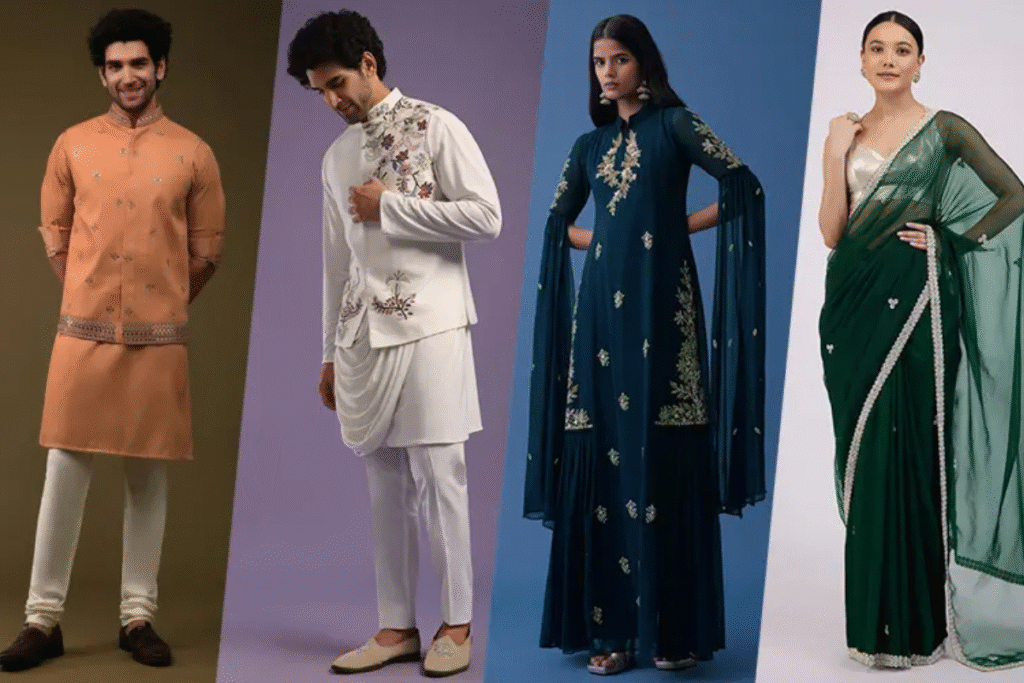I’ve had those moments—status in my closet, eyeing all my garments, questioning: which one honestly represents me these days? Then I slip into one of my favorite stylish ethnic outfits and feel relaxed. It’s not about drama. It’s about feeling grounded and yet slightly elevated.
Why I’ve Turned to Stylish Ethnic Outfits
I didn’t start off thinking I’d fall in love with stylish ethnic outfits. I was all about basics. But slowly I realized that mixing in cultural elements—color, weave, texture—brings me joy. Makes me feel connected. Those moments wherein I’m mid-dance at a circle of relatives gathering, the fabric swirling around me, I suppose: this is who I am. And yeah, on occasion, at ease subjects more than ideal.
A Blend of Now and Then
I often pair an embroidered kurta with jeans. Or layer a dupatta over a plain shirt for work. These are present-day stylish ethnic outfits—not trying too hard, however, hinting at subculture. I’ve located it’s the quality way to honor those who I come from without feeling like I’m in dress.
Sometimes I’ll put on a brocade skirt that’s truly especially light and impartial toned. It’s proper, but not too flashy. Paired with a simple white blouse or tee. I tuck it or belt it—it’s playful. That’s why I love stylish ethnic outfits—they give me flexibility.
Fabric Love: Why It Matters
Silk and velvet look beautiful, but sometimes feel too weighty. Now I lean into cotton-silk blends or breathable linen possibilities. I can move. I can breathe. Even after eating too much biryani. Wearing comfortable traditional wear fashion doesn’t feel like I gave anything up—it just adds longevity.
I once wore a linen saree to a brunch and felt breezy the entire afternoon. People asked where it was from—I thanked them, secretly higher on comfort than any compliment. That’s luxurious in my book.
Silhouette Staples I Keep Coming Back To
There are a few silhouettes I automatically reach for:
- A straight kurta with side slits and trousers
- A dhoti skirt with a crop choli
- A flowy kaftan with leggings or long patchwork rock
- A pleated skirt with a soft blouse
These stylish ethnic outfits feel undying and approachable—capable of landing at festive dinners or informal get-togethers with no trouble.
Accessories: Just One Statement Piece
I used to think more earrings = better. Now, I pick one piece—a chunky ring or a single handbag with ethnic print—and let the stylish ethnic outfits echo the rest. Sometimes a pearl drop earring is paired with brass bangles. Sometimes a bold jhumka with minimal dress. I’ve realized designer ethnic wear doesn’t need to scream opulence—just a quiet mood.
Shoes That Change Everything
Again, comfort. Juttis, sandals, block heels—I pick what lets me move. I don’t want to tiptoe through an event. I want to dance, greet, and walk. Shoes matter more than anyone tells you. Even small flats in metallic tones can lift a kurta look. Shoe picks are an expression of the difference between being dressed and being styled.
Styling with Layers (Because Weather Is Unpredictable)
Fabrics change with the climate, and styling changes with updates. Yesterday it was a cotton shrug over a tee-and-pajama, today it’s a sheer dupatta pinned as a scarf. You can adapt modern traditional outfits by just adding or removing layers.
A jacket over a saree? A waistcoat over a tunic? Those things shift the tone instantly. They make it feel like intentional fashion, not random draping.
Where Comfort Meets Culture
These days, when I pull on one of my favorite stylish ethnic outfits, I’m choosing something comfy. But also meaningful. It’s not a costume. It’s identity. And dressing like that doesn’t require perfection. It just takes respect. A little pride. And an open mind to mixing stuff up.
Fabrics, hues, everyday motion—when something fits you, it resonates.
Something I Learned the Hard Way
I once thought everything had to be subtle and muted. Too afraid to put on a brilliant kurta in public. Then someone complimented it and said it reminded them of summer season festivals in my hometown, which I’d almost forgotten approximately. I found out I turned into a gambling small for no cause.
Now, Iamn bright. I own bold reds, greens, ochres. I let the fabric be loud if I’m feeling it. That’s freedom. That’s what stylish ethnic outfits invite—you can pick your voice.
Making It Easy: Reusing, Re-styling, Reimagining
A sari blouse from five years ago gets worn with pants now. A lehenga skirt becomes a skirt for lunch with flats and a tee. A dupatta gets worn as a scarf. There’s no shame in repeating. In remixing. In breathing new life into old pieces. That’s wisdom, not limitation.
Real Life Is the Best Runway
Most nights, my outfit is about comfort amplified. No one’s watching. I’m cooking, cleaning, and dancing to music. But when I slip into a stylish ethnic outfits, I shift. It signals care. That shift isn’t about vanity—it’s about presence. Cultural presence, personal presence, emotional presence.
Conclusion
If you’re eyeing stylish ethnic outfits that say yes to tradition and yes to ease, know this: you don’t need all glitz. A simple drape, a soft print, or even an embroidered cuff can make a difference. When you add small modern touches, it becomes modern traditional outfits—fresh, fluid, expressive.
Whether you’re exploring designer ethnic wear or just trying to pair traditional with everyday style—do it on your terms. Wear what makes you feel both rooted and empowered. That is the essence of traditional wear fashion done well.
And if you’d love a curated source to shop from or get inspired by looks that marry heritage with ease, FeedFashion showcases collections and ideas just like that. Pieces that flow, breathe, and tell stories—without overcomplicating. That’s the kind of styling worth wearing.

